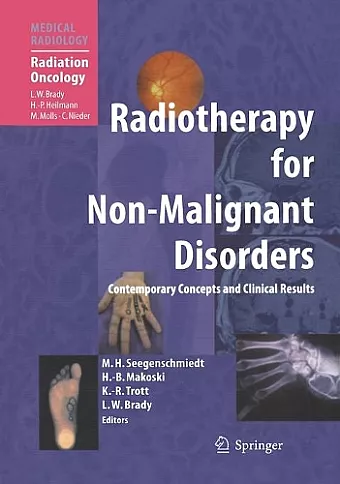Radiotherapy for Non-Malignant Disorders
Luther W Brady editor Michael Heinrich Seegenschmiedt editor Hans-Bruno Makoski editor Klaus-Rüdiger Trott editor
Format:Hardback
Publisher:Springer-Verlag Berlin and Heidelberg GmbH & Co. KG
Published:19th Oct '07
Currently unavailable, our supplier has not provided us a restock date

Radiation Oncology
Non-malignant, or "benign", diseases can be successfully treated using ionizing rad- tion technologies. Many of the non-malignant diseases can have a major and lasting effect on quality of life by causing pain or other serious symptoms, particularly when other methods of treatment are unavailable, have failed, or may induce more side effects.Non-malignant, or "benign", diseases can be successfully treated using ionizing rad- tion technologies. It was first proposed in 1898 by Sokoloff, who reported the analgesic effects of radiotherapy for painful rheumatoid arthritis. Since then, the use of these techniques for painful muscle-skeletal diseases has gained acceptance particularly in Europe but is still carried out actively in the United States. Non-malignant diseases that are amenable to radiotherapy can be classified as inflammatory, degenerative, hype- roliferative, functional, or other disorders. However, the topographic and morphologic considerations are more relevant. Even though radiation therapy for "benign" diseases has not been pursued actively since the 1950s, more recent interest has dictated that it can be a very effective treatment modality. The use of radiotherapy can be justified for invasive and aggressive growth such as that seen with desmoids, for cosmetic d- figurations and functional loss as seen with keloids or endocrine orbitopathy, or for life-threatening complications such as hepatic hemangiomas or juvenile angiofibromas that occur in children or adolescents. Many of the non-malignant diseases can have a major and lasting effect on quality of life by causing pain or other serious symptoms, particularly when other methods of treatment are unavailable, have failed, or may induce more side effects. It is not generally the first choice of therapy in these non-malignant diseases, but it is acceptable as defined. The book edited by Seegenschmiedt et al.
From the reviews:
"This all-inclusive book addressing benign conditions that can be treated with radiation covers first principles for the radiobiology and physics associated with treatment and its delivery and then details the conditions, treatment options, and techniques of therapy. … the book is designed for practitioners and all medical specialists, particularly radiation oncologists, orthopedists, surgeons, and ophthalmologists. … an important addition to the literature for radiation oncologists as well as for a broad range of specialists. This is an outstanding resource for residents and clinicians … ." (Ann Pittier, Doody’s Review Service, May, 2008)
"The chapter in the textbook entitled Radiotherapy for Non-Malignant Disorders that covers the treatment of nonmalignant central nervous system (CNS) disorders by using ionizing radiation is a well-written, concise, and organized accounting of the current state of the art for physicians and residents in neurosurgery, neurology, neuro-oncology, medical physics, and radiation oncology. … is an excellent reference guide for any clinical member of the treatment team for these diseases." (American Journal of Neuroradiology, Vol. 29, November-December, 2008)
ISBN: 9783540625506
Dimensions: unknown
Weight: unknown
748 pages
2008 ed.